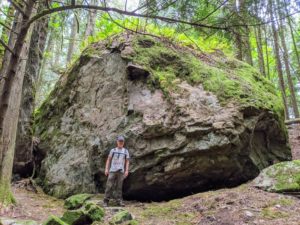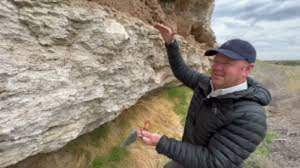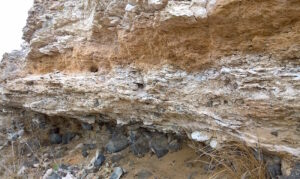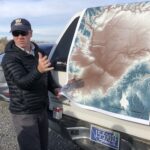
Geology of Tamanowas Rock and Peregrines Rock, Chimacum, WA
Click here for the registration form.

On Saturday, July 8, 2023, several QGS geologists led a 4-mile, 4-hour hike (12 PM—4 PM) from HJ Carroll County Park near Chimacum to the Tamanowas Rock Sanctuary, then up on top of Tamanowas Ridge to see Peregrine’s Rock. The elevation gain on the walk is about 300 ft. This is a repeat of our 2022 trip and includes a 13-page illustrated guidebook.
The upper part of the trail is moderately difficult but slow paced and the hike is tailored to agile citizen scientists who are knowledgeable about basic geologic principles and vocabulary. Subjects to be discussed include the glacial history of the Quimper Peninsula and Chimacum Valley, glacial erratics on the peninsula, and the geology of the underlying Eocene volcanic rock that forms Tamanowas Rock, which is a special part of this story and a sacred place of the S’Kallum people. Allie Taylor of the Jamestown S’Kallum Tribe described the history of the site and its importance to the Tribe.
Tamanowas Rock is a remnant of deposits from an explosive volcano that stood near here about 43 million years ago; it is comprised of adakite, an uncommon type of rock that forms when subducted oceanic plate melts. Aadakite requires unusually hot conditions in the mantle, which in this case occurred during establishment of the Cascades.
Conversely, Peregrine’s Rock is a glacial erratic named by Erik Nagle, a participant in our 2020 Great Erratic Challenge. It currently is the largest erratic documented on the Quimper Peninsula. We believe that it is greenstone (metamorphosed basalt) that originated to the north, perhaps in Canada.
The field trip cost was $20, and limited to 40 persons. Click here for the registration form.


 Calcrete is a CaCO3-rich hardpan paleosol that forms in dry, stable landscapes of the world. Calcrete in eastern Washington cements a 20-m-thick interval across three geomorphic domains: Palouse Hills, Channeled Scablands, and Yakima Fold Belt. The sheet-like calcrete deposit encloses ancient Scabland flood gravels and defines a regional paleosurface that has been bent and broken by Quaternary faults. Calcrete overprints primarily lowland alluvial deposits (ancestral Columbia-Snake River floodplain) and basaltic alluvial fan gravels shed from fault-bounded ridges. Thick layers of pedogenic carbonate accumulated during the Pleistocene, between about 1.8 million years ago to about 40 thousand years ago, but older cements at somewhat deeper levels date back to ~7 million years (late Miocene). The appearance of arid-land calcrete in eastern Washington coincides with the topographic rise of the Cascade Range and establishment of a strong rain shadow east of the divide. This lecture shed new light on this lesser-known part of eastern Washington’s stratigraphy.
Calcrete is a CaCO3-rich hardpan paleosol that forms in dry, stable landscapes of the world. Calcrete in eastern Washington cements a 20-m-thick interval across three geomorphic domains: Palouse Hills, Channeled Scablands, and Yakima Fold Belt. The sheet-like calcrete deposit encloses ancient Scabland flood gravels and defines a regional paleosurface that has been bent and broken by Quaternary faults. Calcrete overprints primarily lowland alluvial deposits (ancestral Columbia-Snake River floodplain) and basaltic alluvial fan gravels shed from fault-bounded ridges. Thick layers of pedogenic carbonate accumulated during the Pleistocene, between about 1.8 million years ago to about 40 thousand years ago, but older cements at somewhat deeper levels date back to ~7 million years (late Miocene). The appearance of arid-land calcrete in eastern Washington coincides with the topographic rise of the Cascade Range and establishment of a strong rain shadow east of the divide. This lecture shed new light on this lesser-known part of eastern Washington’s stratigraphy. The Speaker
The Speaker